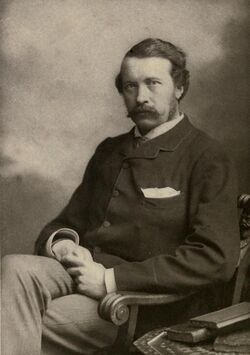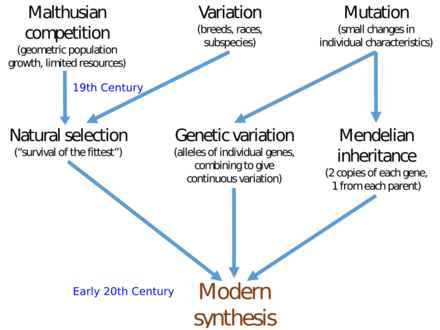Biology:Neo-Darwinism
Neo-Darwinism is generally used to describe any integration of Charles Darwin's theory of evolution by natural selection with Gregor Mendel's theory of genetics. It mostly refers to evolutionary theory from either 1895 (for the combinations of Darwin's and August Weismann's theories of evolution) or 1942 ("modern synthesis"), but it can mean any new Darwinian- and Mendelian-based theory, such as the current evolutionary theory.
Original use
Darwin's theory of evolution by natural selection, as published in 1859, provided a selection mechanism for evolution, but not a trait transfer mechanism. Lamarckism was still a very popular candidate for this. August Weismann and Alfred Russel Wallace rejected the Lamarckian idea of inheritance of acquired characteristics that Darwin had accepted and later expanded upon in his writings on heredity.[1](p108)[2][3] The basis for the complete rejection of Lamarckism was Weismann's germ plasm theory. Weismann realised that the cells that produce the germ plasm, or gametes (such as sperm and eggs in animals), separate from the somatic cells that go on to make other body tissues at an early stage in development. Since he could see no obvious means of communication between the two, he asserted that the inheritance of acquired characteristics was therefore impossible; a conclusion now known as the Weismann barrier.[4]
It is, however, usually George Romanes who is credited with the first use of the word in a scientific context. Romanes used the term to describe the combination of natural selection and Weismann's germ plasm theory that evolution occurs solely through natural selection, and not by the inheritance of acquired characteristics resulting from use or disuse, thus using the word to mean "Darwinism without Lamarckism."[5][6][7]
Following the development, from about 1918 to 1947, of the modern synthesis of evolutionary biology, the term neo-Darwinian started to be used to refer to that contemporary evolutionary theory.[8][9]
Current meaning
Biologists, however, have not limited their application of the term neo-Darwinism to the historical synthesis. For example, Ernst Mayr wrote in 1984 that:
- The term neo-Darwinism for the synthetic theory [of the early 20th century] is sometimes considered wrong, because the term neo-Darwinism was coined by Romanes in 1895 as a designation of Weismann's theory.[10][11][7][12]
Publications such as Encyclopædia Britannica use neo-Darwinism to refer to current-consensus evolutionary theory, not the version prevalent during the early 20th century.[13] Similarly, Richard Dawkins and Stephen Jay Gould have used neo-Darwinism in their writings and lectures to denote the forms of evolutionary biology that were contemporary when they were writing.[14][15]
See also
- History of evolutionary thought
References
- ↑ Darwin, Charles (1872). The Origin of Species by Means of Natural Selection, or the Preservation of Favoured Races in the Struggle for Life (6th ed.). London: John Murray. OCLC 1185571.
- ↑ Darwin, Charles (1868). The Variation of Animals and Plants Under Domestication (1st ed.). London, UK: John Murray. http://darwin-online.org.uk/EditorialIntroductions/Freeman_VariationunderDomestication.html.
- ↑ Kutschera, Ulrich (December 2003). "A comparative analysis of the Darwin-Wallace papers and the development of the concept of natural selection". Theory in Biosciences 122 (4): 343–359. doi:10.1007/s12064-003-0063-6. ISSN 1431-7613.
- ↑ Barbieri, Francisco D. (1989). "The origin of Metazoa and Weismann's germ line theory". Rivista di Biologia 82 (1): 61–74. ISSN 0035-6050. PMID 2665023.
- ↑ Gould, Stephen Jay (2002). The Structure of Evolutionary Theory. Cambridge, MA: Belknap Press of Harvard University Press. p. 216. ISBN 978-0-674-00613-3. OCLC 47869352.
- ↑ Beccaloni, George (2013). "On the terms "Darwinism" and "Neo-Darwinism"". https://wallacefund.myspecies.info/terms-darwinism-and-neo-darwinism.
- ↑ 7.0 7.1 Reif, Wolf-Ernst; Junker, Thomas; Hoßfeld, Uwe (March 2000). "The synthetic theory of evolution: general problems and the German contribution to the synthesis". Theory in Biosciences 119 (1): 41–91. doi:10.1007/s12064-000-0004-6. ISSN 1431-7613. http://www.thomas-junker.homepage.t-online.de/pdf/00rjhtb.pdf.
- ↑ Moran, Laurance (January 22, 1993). "The Modern Synthesis of Genetics and Evolution". Houston, TX: The TalkOrigins Foundation, Inc.. http://www.talkorigins.org/faqs/modern-synthesis.html.
- ↑ Bock, Walter J. (July 1981). "Reviewed Work: The Evolutionary Synthesis. Perspectives on the Unification of Biology". The Auk 98 (3): 644–646. ISSN 0004-8038.
- ↑ Mayr, Ernst (1984). "What is Darwinism Today?". PSA: Proceedings of the Biennial Meeting of the Philosophy of Science Association 1984 (2): 145–156. doi:10.1086/psaprocbienmeetp.1984.2.192502. ISSN 0270-8647. Volume Two: Symposia and Invited Papers (1984).
- ↑ Kutschera, Ulrich; Niklas, Karl J. (June 2004). "The modern theory of biological evolution: an expanded synthesis". Naturwissenschaften 91 (6): 255–276. doi:10.1007/s00114-004-0515-y. PMID 15241603. Bibcode: 2004NW.....91..255K.
- ↑ Pigliucci, Massimo (December 2007). "Do We Need An Extended Evolutionary Synthesis?". Evolution 61 (12): 2743–2749. doi:10.1111/j.1558-5646.2007.00246.x. PMID 17924956.
- ↑ "neo-Darwinism". Encyclopædia Britannica. Chicago, IL: Encyclopædia Britannica, Inc.. 2015. http://www.britannica.com/science/neo-Darwinism. Retrieved 2015-11-19.
- ↑ "Neo-Darwinism Lecture by Richard Dawkins" on YouTube. The video of the lecture was originally posted on May 5, 2010, at old.richarddawkins.net: "Lecture on Neo-Darwinism". http://old.richarddawkins.net/videos/1345-lecture-on-neo-darwinism..
- ↑ Gould, Stephen Jay (2011). "Challenges to Neo-Darwinism and Their Meaning for a Revised View of Human Consciousness". in McMurrin, Sterling M.. The Tanner Lectures on Human Values. 6. Salt Lake City, UT; Cambridge, UK: University of Utah Press; Cambridge University Press. pp. 53–73. ISBN 978-0-521-17647-7. OCLC 846869183. "Lecture delivered at Clare Hall, Cambridge University April 30 and May 1, 1984"
 |




